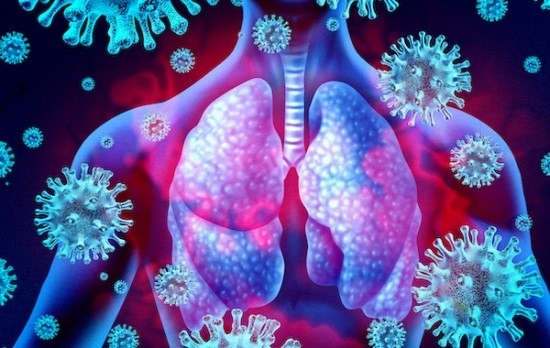Acute respiratory infections, which are attributed either to a bacterial pathogenic agent or a viral infection, are responsible for the death of 4.5 million people worldwide, and they rank third in causing death, after heart diseases and stroke. In addition to the age factor – school-age and preschool-age children, as well as the elderly, are the most vulnerable to respiratory infections – various predisposing factors have been identified, such as allergies, asthma, diabetes, heart disease, lung disease, smoking, and others. Specifically, it has been observed that in individuals under one year of age and over 65 years, secondary complications may arise following the onset of flu-like symptoms, although these infections are usually self-limiting and are primarily found in the upper respiratory system.

Image source : https://utswmed.org/medblog/lifecycle-of-a-coronavirus/
Considering that an average child may experience 10-14 episodes of flu-like syndrome per year and an adult approximately 6-8, it becomes clear that respiratory infections, which are divided into upper and lower respiratory tract infections, are the most frequent in the life of every person.
Upper respiratory tract infection, commonly known as the common cold, usually manifests with low fever (below 38°C), a runny nose, cough, sore throat, headache, and conjunctivitis. It is caused by more than 200 types of viruses, some of which are listed below, which explains its frequency. The influenza virus, which has a global distribution, may initially present either as a common cold that develops into pneumonia or as pneumonia from the onset.
The influenza virus is the main pathogenic agent responsible for the majority of respiratory system infections, especially during peak months, from January to March. The increase in morbidity and mortality caused by seasonal influenza varies from year to year, depending on the characteristics of the circulating virus and the level of immunity in the population's various age groups. It is particularly important to mention the surveillance program conducted by the National Influenza Reference Center of Southern Greece at the Diagnostic Department of the Hellenic Pasteur Institute, in collaboration with the EODY, aimed at documenting the activity of influenza in the Greek population. Other viral agents that lead to respiratory system infections with similar symptoms to influenza include rhinoviruses, respiratory syncytial virus, adenoviruses, parainfluenza viruses, metapneumovirus, and others. The respiratory syncytial virus is the leading cause of hospitalization in children under 15 years old and the second leading cause of mortality caused by pneumonia and lower respiratory tract infections worldwide. The metapneumovirus causes a clinical picture similar to that of respiratory syncytial virus and is responsible for 4-16% of acute respiratory infection episodes globally.
In addition to viral agents causing respiratory infections, bacterial pathogens also play a very significant role. Lower respiratory tract infections include bronchitis and pneumonia, clinical conditions that are fortunately less common and are mainly caused by bacteria, with the main representative being Streptococcus pneumoniae, a bacterium associated with a mortality rate that can exceed 10% of those affected by pneumonia. Bacteria from the genus Streptococcus, the genus Haemophilus, and Moraxella catarrhalis are responsible for upper and lower respiratory tract infections in 40-50% of cases, with the latter bacterium being particularly common in young children. The role of Mycoplasma pneumoniae and Chlamydophila pneumoniae is minimal in upper respiratory infections but they are responsible for 5-10% of lower respiratory tract infections.
Our arsenal today includes many antimicrobial drugs that play a particularly important role in bacterial infections, in contrast to viruses, for which unfortunately no antiviral drugs exist, except for those targeting the replication of the influenza virus. This, combined with the fact that many respiratory infections remain undiagnosed or are accompanied by an empirical clinical diagnosis without accompanying laboratory confirmation, makes laboratory diagnosis of respiratory infections even more important. Laboratory diagnosis can achieve the timely limitation of disease transmission, as much as possible, the rational use of antibiotics, and more accurate prognosis to avoid subsequent secondary complications. Molecular Syndromic Diagnosis of Respiratory System Infections conducted at the Diagnostic Department of the Hellenic Pasteur Institute.
| Viruses | Bacteria | |
| Respiratory syncytial virus | Types (Α+Β) | Mycoplasma pneumoniae |
| Parainfluenza Virus | Type 1 | Haemophilus influenzae |
| Type 2 | Streptococcus pneumoniae | |
| Type 3 | Legionella pneumophila | |
| Type 4 | Bordetella pertussis | |
| Rhinovirus | Bordetella parapertussis | |
| Metapneumovirus A & B | Chlamydophila pneumoniae | |
| Boca virus | Mycobacterium sp. | |
| Corona Virus | 229 Ε | Tropheryma whipplei |
| NL63 | Pseudomonas aeruginosa | |
| HKU1 | ||
| OC43 | ||
| Sars Cov2 | ||
| Pareco virus | ||
| Enterovirus | ||
| Adenovirus |
